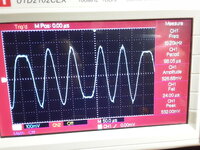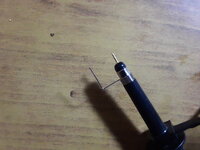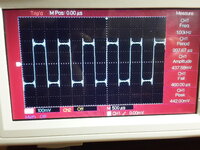fm101
Member level 5

I have a new digital storage oscilloscope, utd2102cex which says 100MHz bandwidth and 1GS/s sampling rate. I am not sure whether it is working correctly or is malfunctioned in which case I will have to return it. The problem is I measured 10KHz square wave output generated from audio soundcard with the oscilloscope the waveform does not appear square wave which is shown below.

I tried functionality provided by the oscilloscope(https://www.manualslib.com/products/Uni-T-Utd2102cex-8824295.html) but can't get a square wave waveform. I tried using the ground spring(usually used for RF range) shown below and I guess 10KHz square wave should be easily drawn with/without ground spring.

But at frequencies below 2KHz the signals(sawtooth, triangle, square wave) appears as expected. Below is 1KHz square wave on DSO.

Does it look like the oscilloscope is malfunctioned because 10KHz is not that high frequency and should be easily sampled and plotted by the DSO. If it is I have to return it immediately. Any advice on this matter.
Thank you

I tried functionality provided by the oscilloscope(https://www.manualslib.com/products/Uni-T-Utd2102cex-8824295.html) but can't get a square wave waveform. I tried using the ground spring(usually used for RF range) shown below and I guess 10KHz square wave should be easily drawn with/without ground spring.

But at frequencies below 2KHz the signals(sawtooth, triangle, square wave) appears as expected. Below is 1KHz square wave on DSO.

Does it look like the oscilloscope is malfunctioned because 10KHz is not that high frequency and should be easily sampled and plotted by the DSO. If it is I have to return it immediately. Any advice on this matter.
Thank you
Last edited by a moderator:



